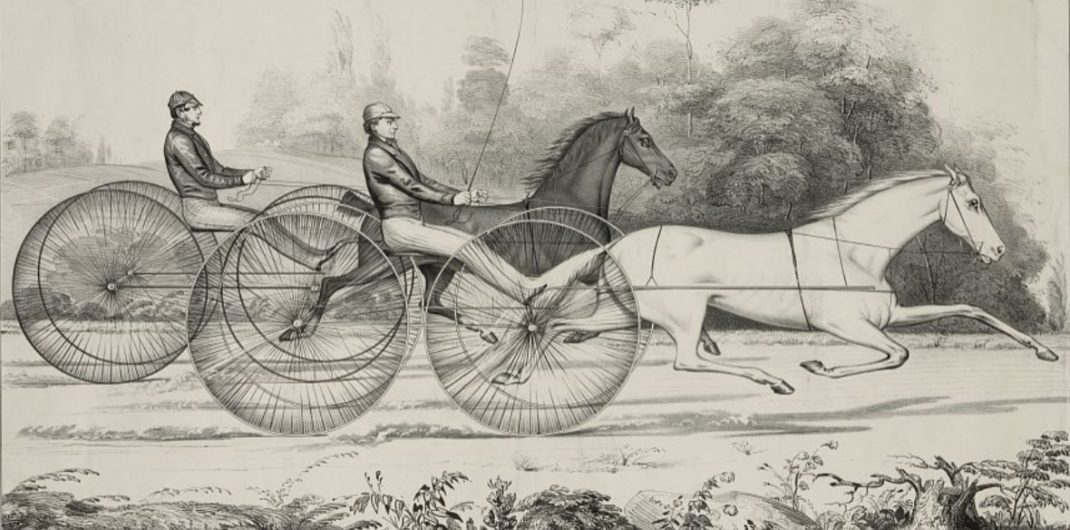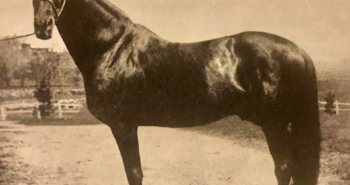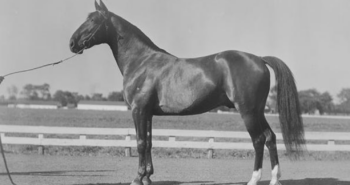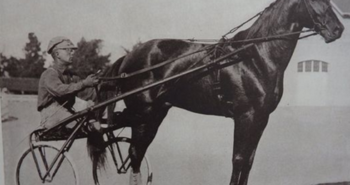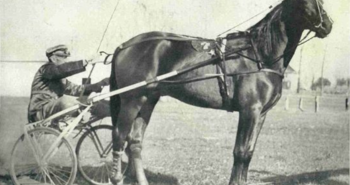Known as the “The Queen of the Turf”, she was the first to break the magic 2:30 barrier. A victim of bad and harsh treatment on many occasions, Lady Suffolk never sulked or quit.
Owned by Leonard Lawrence of Smithtown but born at the farm of Carl S Burr Jr in Commack ( Smithtown) in June 1833, Lady Suffolk was sold to David Bryan as a four-year-old. According to John Hervey’s book Lady Suffolk, The Old Grey Mare of Long Island, Lawrence “had no desire to keep the little thing and upon weaning her in the fall sold her for $60 to Charles Little. It was from Little that Richard Blydenburgh bought her, just when seems uncertain, but probably when she was a two-year-old; and again the accounts vary as to the valuation, which was perhaps $90. Blydenburgh was a butcher in Smithtown, and put her to work between the shafts of his cart. Tradition asserts that she was pulling it about Smithstown loaded with bivalves when David Bryan saw her and bought her for $112,50. That was in 1837, when she was four year sold.” Bryan ran a country town livery stable in Smithstown and presumably acquired the mare to work transporting people around. At first, he had no plans to race the mare.
From Hervey’s book, “She could not have been in Bryan’s possession very long when one day two gentlemen from ‘the city’ hired her to drove to Commack. They were not ordinary patrons. One of them was none other than William T Porter himself, who in the four years since he began editing the Spirit of the Times had made both it and himself famous. The other was his close friend and contributor James Oakes, Esq., of Boston, known to the readers of the Spirit as Acorn, over which name he kept them abreast of sporting and dramatic affairs of the Hub of the Universe. The editor was touring the sporting and breeding regions of the Island with his visitor from the Back Bay. We have no means of knowing just what was taking them to Commack; perhaps it was to call at Smith Burr’s farm to have a look at his stallion Engineer II and Napoleon. And perhaps it was for that reason that David Bryan gave them his newly acquired Engineer filly to drive. The more one thinks it over, the more probable it seems. The outcome of their drive behind her was momentous. The day was fine; the road was smooth; the filly was full of a desire to go, the change from an oyster cart having proved agreeable. The two connoisseurs of speed decided to let her step so that they might see what kind of stuff was in her. And the result astonished them so much that when they turned her back to David Bryan, Porter seriously advised him to made a race mare out of her, advice so acceptable to Bryan that he determined to follow it.”
The unmerciful trainer
The following year, in February 1838, she started her first race, under saddle, at Babylon, Long Island. After winning two out of three heats from Sam Patch, the grey mare took home $11. Lady Suffolk was ridden by legendary Hiram Woodruff in her first public performance, where she won in 3:01 and 3:00 (1.52,5 and 1.51,9). Officially her best winning time was 3:01, but Woodruff insisted in his own book that the third heat was won in 3:00.
Woodruff would ride and drive the mare in many races, but was never her trainer. This probably prevented Lady Suffolk from having an even greater career, because David Bryan had no experience training trotters nor, according to historical accounts, the aptitude for it. He was, as stated by Woodruff, “a hard, reckless master” driven by greed and “had no notion of letting her stand still when there was the ghost of a chance to make a few dollars.” Woodruff further stated that David Bryan “knew but little about the management of trotting horses”. John Hervey points out that “as a reinsman he was chiefly noted for his heavy hands and unmerciful use of the whip. He had little judgment of pace, and would drive her to a break without cause, then snatch, whip and punish her. What a marvel she must have been to never sulk, rebel or fight back, but always and invariably giving her all of speed, strength and endurance under extreme and at times insensate demands that were made upon her!”
And Bryan put “insensate demands” on the grey mare. Her next start was a two-heat two-mile race at Beacon Course on Jun 20, where she finished second to Apollo and George Spicer. Just two days later her owner entered her in an identical race at Beacon Course. Then “so little was thought of Lady Suffolk’s chances that none of the professionals present would ride her, in consequence of which Bryan himself got up on her, and made a poor figure in what was to him a role never before attempted.” Despite this, Lady Suffolk won each heat in 5:15 and 5:17 (1.37,9 and 1.38,5), respectively. On Jul 4, the tough schedule was showing. After beating Peter Whelan’s gelding Rattler in the first heat, but lost the second and was clearly tired. Bryan asked Woodruff to ride the mare in the third and deciding heat, which the legendary horseman only unwillingly accepted after “promising he would not punish her uselessly if he saw she was beaten.” Lady Suffolk was in no shape for yet another heat and she was finally given a three month rest.
Looking to cash in
But in October 1838, Bryan made up for lost time by starting five times in 18 days, four two-mile heat races and the fifth consisting of three-mile heats. She was beaten at the Beacon Course on Oct 1, 8 and 15. Writes Hervey, “it is doubtful if she was fully cooled out from it before she was started over the road for the Hunting Park Course in Philadelphia, where she was due to start the next day but one. This was in 1838, when there were as yet only a few hundred miles of railroad in operation in the whole country, and it was not until long afterward that the shipment of race horses by train began. Although it was all of seventy-file miles from Beacon to Hunting Park, a hundred years ago such a performance was not seldom asked of race horses. Nevertheless, she made the journey, and in such good form that when on he 17th she turned for the word in Philadelphia, two miles to the saddle, she had no difficulty in beating two others in 5:18, 5:26 (1.38,8 and 1.41,3). But of course there was a limit and when the very next day the merciless Bryan saddled her again to go three-mile heats against Rattler, Lady Victory and Ben Franklin, she finished in third position.”
It had been an impressive first campaign for Lady Suffolk, who had face several of the better trotters of her time but acquitted herself impressively. David Bryan now saw an opportunity to cash in, and on Dec 8, 1838, the following ad appeared in the Spirit of the Times:

Breaking the 2:30 barrier
Maybe potential owners considered the price too steep or maybe they doubted she would last long given Bryan’s demands on her – either way, nobody came forward to buy and the grey mare and Lady Suffolk remained David Bryan’s property until the day she died. Over the next couple of years, Lady Suffolk improved steadily and would soon be the undisputed queen of the tracks. Again she didn’t do this because of her owner and trainer, but rather despite him. Nothing exemplifies this better than her two days at the Cambridge Course in Boston on Nov 15 and 16, 1839. On the first day Lady Suffolk was started against Ellen Jewett at four-mile heats under the saddle, winning in 11:22 and 11:34 (1,46,0 and 1.47,8). Later that afternoon she went mile heats against the very good Independence, losing in three straight heats. The following day she was started in a rematch against Independence. After losing the first two, Lady Suffolk won the next two in 2:49 and 2:47 (1.45,0 and 1.43,8) before losing the fifth and final heat. The grey mare thus raced 16 miles (25,7 kilometers) in roughly 24 hours.
On Sep 24, 1840, Lady Suffolk won a match race at Centreville, Long Island, against one of her arch-rivals, Dutchman, trotting the first heat under saddle in 4:59 (1.32,9). It was the first time ever a trotter had averaged under 2:30 on a two-mile course. In the second heat she won easily in 5:03 1/2 (1.34,3), thus completing a two-heat world record. At the end of 1840 she was “generally regarded as the best trotter in America, though by no means having yet reached her limit.”
The 1842 season saw Lady Suffolk set a team four-wheeled world record when she and Rifle trotted 5:19 (1.39,1) in a race in Philadelphia. Additionally she started six times by herself, all in harness, but “only” won two of those. Several voiced the opinion that Lady Suffolk’s career had reached its peak and that she was, as Hervey put it, “marching toward the sunset”. Nothing would, however, be further from the truth about the beautiful mare – though not everybody agreed with that opinion. From the Spirit of the Times, “Lady Suffolk was about fifteen hands and a half high; of a beautiful grey, with a large sweeping tail; small head, well set on to a fine arched neck, with a good deal of the Arab about it; large shoulders and quarters, not too heavy, but showing immense strength and power of endurance; long in the body, legs fine and wonderfully good.” However, after her death, the Middlebury Register and Addison County Journal described her quite differently when reporting on her passing: “She was an ungainly appearing beast, with nothing noticeable about her unless it were her very ugliness of form and gait, but for many years she has been capable of showing her heels to almost any of the fast horses of the country, and has won a first class reputation for speed.” Beauty certainly is in the eye of the beholder.
A legendary match race
Lady Suffolk started her 1843 campaign on Jul 4 at Beacon Course. It was a race under saddle, and, in the words of Hervey, “as Bryan was overweight, he was induced to allow young Albert Conklin, son of the veteran Long Island horseman Joel Conklin, to ride her, since he could make 143 pounds, which was two below the scale.” Up against Independence and the Canadian-born Morgan horse Beppo, by many considered the speediest horse around, in part because he was once clocked in 1:09 (1.25,8) in a trial half, a rate unheard of at the time. After her somewhat disappointing season the year prior, Lady Suffolk was third choice in the betting behind Beppo and Independence.
In the first heat Beppo broke, while Independence and Lady Suffolk trotted “the whole mile almost like a team”, the mare winning in 2:28 1/2 (1.32,3). This beat the world record for a mile to saddle, jointly held by Beppo and Edwin Forrest, by a whole three seconds. In the second heat Independence and Lady Suffolk battled it out in front while Beppo had cover for most of the trip. Down the stretch the grey mare pulled away from Independence, but Beppo whirled up on the inside and the duo made a dead heat in 2:28 (1.32,0), lowering her fresh world record. The third heat was almost exactly the same. Lady Suffolk fought gamely and pressured Independence to a break in the final stretch, but this time Beppo managed to beat the mare by half a head. In the fourth heat, “Conklin sent Lady Suffolk out in front, apparently confident that her bottom and courage were endless. Nobly she responded. She soon put daylight between her and Independence, who began to fall back so fast that Spicer saw he must make a move with Beppo or she would make a runaway race of it. So he went after his mount and shot past Independence, when that gelding, recovering his second wind, made a sudden rush that carried Beppo to a break. The mare had clear sailing; and how she sailed! She went so fast, so far, that Conklin pulled her down at the finish and she won as she pleased in 2:29 (1.32,6) and could have made it in 2:27 (1.31,4) or less.” In the fifth and final heat Lady Suffolk uncharacteristically went off-stride midway through race, but recovered to win in 2:32 (1.34,5). According to Hervey, “even the losers could not withhold the meed of their enthusiastic applause for ‘the Grey Mare’, who had indeed proved herself the better horse.”
Eight days later she improved on this when she beat Beppo and the pacer Oneida Chief, in a sulky, in 2:26 1/2, 2:27 and 2:27 (1.31,1, 1.31,4, and 1.31,4) at Beacon Course. The grey mare started ten times in 1843, winning 6. Three of her losses a result of Bryan’s demands, starting when she clearly wasn’t fit, and the final time as a result of George Spicer and Hiram Woodruff, riding Dutchman and Americus, respectively, took turns working the mare over.
Escaping death
In May 1844, tragedy almost struck. Stabled at Joel Conklin’s stable at Centreville Course, it was struck by lightning and caught on fire on Sat 11. Rescued from the flames together with several other horses in the stable, the grey mare then started her season four days later. Not surprisingly, she won in two straight heats. In was in 1845, though, that Lady Suffolk was at her very best. The 12-year-old had beat 2:30 in a saddle before, but on the Beacon Course on Oct 13, 1845, she defeated General Dunham’s gelding Moscow in five heats in sulky, the second heat in 2:29 1/2 (1.32,9). The grey mare thus established a standard of trotting speed that became official.
Lady Suffolk won the first race at Saratoga on Aug 14, 1847, winning in 2:52, 2:54 and 2:44 (1.46,9, 1.48,1 and 1.41,9) to wagon. She lowered her record under saddle to 2:26 at Boston on Jun 14, 1849. 11 days later she duplicated her 2:29 1/2 (1.32,9) performance at Union Course – 16 years old (!). One week later she defeated Pelham, Jack Rossiter and Lady Moscow 1-1-2-2-1 in five heats, but Pelham took her world record when he won the third heat in 2:28 (1.32,0). It was, however, Lady Suffolk who carried him in that record heat.
Heading to the Big Easy
At the beginning of the 1850 campaign David Bryan had announced it would be Lady Suffolk’s last and that she would be bred in the spring of 1851. Perhaps with this in mind, Bryan and Lady Suffolk set off for New Orleans in late 1850, with the intention to race her there the following winter and spring. On the way there she raced twice in Rochester, twice in Buffalo and once in Cincinnati, all in November 1850. After defeating Jack Rossiter in Cincinnati on Nov 26, Bryan took ill and had to return to Long Island. After recovering he rejoined the then 18-year-old mare at Cincinnati in January 1851, and from there the pair travelled by boat to New Orleans. Shortly after his arrival, Bryan took ill again and this time it became critical. Lady Suffolk was turned over to Albert Conklin, who was unable to prevent the mare from losing all three starts in New Orleans, the only highlight down south being a win in Mobile on Apr 22 at a benefit day for David Bryan’s widow, him passing away on Apr 5, 1851, only 45 years old.
Lady Suffolk was then left in the care of Charles S Ellis, “a Bostonian who had gone west to take up the management of trotting affairs in St Louis, and then on to New Orleans for the same purpose.” He travelled back with Lady Suffolk. On the way back to Long Island, the old grey mare started three times in St Louis and another three at the New York State Fair in Rochester, winning four of the six races.
In the beginning of September 1851, Lady Suffolk was sold to a Mr Gould for $2,400. He at once resold her for $3,200 to John I Snedeker, William Shaw and Ezra White, then the lessees of the Union Course – no surprise, then, that her return to the New York tracks was at Union Course on Oct 15. It was no ordinary return, either, as Lady Suffolk won over five heats.
Her advance age, common sense and welfare also strongly indicated that Lady Suffolk should be retired. However, her new owners wanted to get maximum return on their investment and used the mare to attract people to attend their races. As a result, the mare raced a full season in 852, and also made two starts in October 1853 – aged 20! Lady Suffolk made her final start at Union Course on Oct 27, 1853. By that time Ezra White had bought out his co-owners. According to an article in the New York Times two days later, “Messrs John I Snedeker, Shaw and White, proprietors of the Union Course, who kept her in fine condition, and have now disposed of her to a gentleman named Hannington, for the sum of $2,500, who we understand, makes the purchase for a wealthy gentleman residing at Saratoga Springs, who designs to keep the ‘Old Lady’, as she is familiarly called, for a pet among his livery horses.” That gentleman was Ezra White.
Was she bred twice?
According to her obituary in Spirit of the Times, Lady Suffolk “prematurely” dropped a foal to the famous Morgan Stallion Black Hawk in 1854. That suggests she was bred and in foal during her two starts in Oct 1853. According to John Hervey, writing in 1936, “There is some conflict of evidence here which it is no longer possible to unravel. According to some versions, she was bred to Vermont Black Hawk in the spring of 1853, and then, returned from Vermont, she was replaced in training, and started twice at the Union in October; then she was permanently retired and in the spring of 1854 dropping a premature (dead) foal. Other assert that she was not sent to Vermont until the spring of 1854, and that she never dropped the reputed foal.” That Lady Suffolk lost her foal seems unquestionable, as it was initially reported in the Spirit of the Times on Jan 13, 1855, “She is now in the stable of D Edgar Hill, Esq., on his farm at Bridgeport, VT. Mr Hill informs me that she prematurely dropped a foal last spring, by Black Hawk. It is the intention of Mr Hill to keep Lady Suffolk on his farm for a brood mare, and breed her to no horse but Black Hawk. The old Lady is, I am told, looking nearly as fine as when she was in her five-year-old form, notwithstanding the many bruising races she has trotted.”
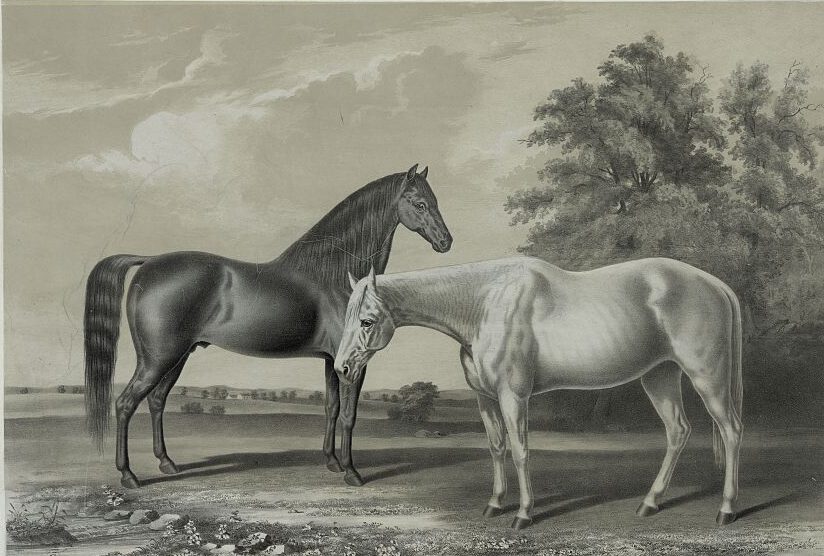
What is certain, is that White had sent the mare to Vermont to breed her to Black Hawk, and that Lady Suffolk was indeed in foal to Black Hawk in the fall of 1854, which was reported in many newspapers, but the rest it is, as Hervey points out, “no longer possible to unravel.” She wouldn’t have any foal, though as tragedy struck on Mar 7, 1855 . According to the Spirit of the Times, “She died at Edgar Hill’s, Bridgeport, VT, in what Mr Hill supposed to be a fit, as she was in apparent health but a short time before she died; Mr H was in the stable when she fell to stand no more. Thus passed from the Turf to a resting place beneath it, an old familiar.”
lady suffolk
Grey mare born in Smithtown, Long Island in Jun 1833. Died in Bridgeport, VT on Mar 7, 1855.
Engineer II – Jenny (Don Quixote)
161 starts*: 88-56-6 – 2:29 1/2 (1.32,9) – $35,011*
Breeder: Leonard Lawrence
Owners: Leonard Lawrence – Charles Little – Richard Blydenburgh – David Bryan – John I Snedeker, William Shaw and Ezra White – Ezra White
Trainers: David Bryan, Jim Whelpley, Albert Conklin and Hills Johnes
Drivers: Hiram Woodruff, David Bryan, Peter Whelan, Albert Conklin, Jim Whelpley, Hills Johnes, Zachary Taylor, Sam McLaughlin, Dan Pifer and Ezra White
Groom: –
A note on her career starts and wins: Lady Suffolk is in some places credited with 89 wins in 162 starts. This is because they are including her successful time trial in 1840 at the Stevens Course in New York. Lady Suffolk was set to beat 2:40 (1.39,4), which she did with ease, trotting in 2:32 (1.34,5).
A note on her earnings: Writes Hervey, “It is impossible to compute exactly her winnings of stakes, purses and matches. In his memoir, published just after her death, Frank Forester placed them at $35,011. Other estimates were much higher, running even to $60,000. During her era the division of money was uncertain, arbitrary, and often not published. Sometimes the entire purse or stake went to the winner. As a rule, only the second horse ever received any part of it.”

